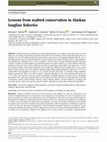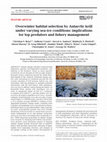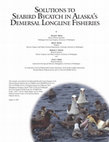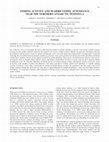Papers by Kimberly Dietrich

Marine ornithology, Oct 15, 2009
We conducted a survey to investigate the factors influencing the number of seabirds attending a r... more We conducted a survey to investigate the factors influencing the number of seabirds attending a research vessel during scientific trawling activities near the northern Antarctic Peninsula. Our objective was to assess whether seabirds exhibited varying levels of attendance that may be attributed to fishing activity. Counts of seabirds attending the vessel were made during non-fishing periods, net deployment, towing and retrieving. We also monitored environmental variables (e.g. pressure, wind speed and direction) and discards of fish and offal to determine whether those variables could be used to explain variability in seabird attendance. Three species, the Black-browed Albatross Thalassarche melanophris, Cape (or Pintado) Petrel Daption capense and Wilson's Storm-Petrel Oceanites oceanicus were the most common seabirds attending the vessel. We found that abundance of seabirds did not vary between fishing activities, although the presence of discards caused an increase in the numbers of petrels and albatrosses. Our study is the first to examine seabird-vessel attendance to scientific trawling activities in Antarctic waters where a moratorium on commercial finfish fishing is in place. In comparison with other studies, the level of fishing conducted during this study does not come close to approaching that of commercial fishing (i.e. catch rate and fishing duration). Nevertheless, it is important to monitor seabird attendance at fishing vessels so that proper mitigation and conservation actions are met to protect seabirds.

Net tows were completed during Leg II of the 2008/09 AMLR Survey in the South Shetland Islands to... more Net tows were completed during Leg II of the 2008/09 AMLR Survey in the South Shetland Islands to complement data collected the previous year, as well as fi nfi sh data collected during the same cruise. During this survey: • Nineteen tows were completed at randomly selected stations throughout the South Orkney Islands; • A total of 5,204 krill were caught, the majority of which were found to the northwest of Coronation Island; and • Krill caught exhibited a unimodal length-frequency distribution around 44-48 mm. Figure 12.1. Geographic distribution and abundance of krill caught during Leg II of the 2008/09 AMLR Survey. Introduction During Leg II of the 2008/09 AMLR Survey, net-tow samples were taken in the South Orkney Islands to aid in measuring the meso-scale distribution of Antarctic krill (Euphausia superba) and support acoustic biomass estimates of krill. This is the second survey conducted in the South Orkney Islands during the International Polar Year. The data collected during this year’s survey will complement last year’s data to map zooplankton distribution, abundance and demography in the South Orkney Islands. Methods Net tows were completed using a 1.8 m Isaacs-Kidd Midwater Trawl (IKMT) fitted with a 505 μm mesh plankton net. All tows were fished to 170 m, or to within 10 m of the bottom where shallower. Real-time tow depths were measured using a depth recorder mounted on the trawl bridle. Flow volumes were measured using a calibrated General Oceanics flow meter mounted on the frame in front of the net. Tow speeds were maintained at two knots. Postlarval krill were removed from the sample counted, measured, and sexed. If the krill catch was greater than 100, a subset of 100 individuals were randomly selected and measured. Measurements were made of total length (mm) from the rostrum to the tip of the telson. After the krill were measured, they were returned to the remaining sample, which was preserved in formalin and stored at the Southwest Fisheries Science Center. Results A total of 19 IKMT tows were completed at stations associated with the stratified random trawl survey stations (Chapter 9). Krill were found in 10 of the 19 tows, yielding a total of 5,204 krill. The largest catch of krill was northwest of Coronation Island, where 4,912 krill were caught in a single tow (Figure 12.1). Several smaller catches were encountered to the southeast of the South Orkney Islands shelf, near the 250 m isobath. Of the total krill catch, 865 krill were measured and sexed. The length-frequency distribution of krill in the Figure 12.2. Length-frequency distribution of krill caught during Leg II of the 2008/09 AMLR Survey.

Progress in Oceanography, Aug 1, 2021
Abstract Climate forcing is impacting polar marine ecosystems through increased variability of wi... more Abstract Climate forcing is impacting polar marine ecosystems through increased variability of winter sea-ice dynamics, which likely influences the distribution, abundance and structure of zooplankton assemblages, and thereby trophodynamics of marine food webs. Due to the challenges of working in polar marine ecosystems, most knowledge on polar zooplankton community structure is derived from summer surveys. Here we examine the spatial distribution, abundance and community structure of macrozooplankton in relation to sea-ice and ocean-climate dynamics within the Antarctic Peninsula marine ecosystem over five consecutive winters. We compare the patterns revealed during winter with historical data collected in the same region during austral summer. Hydrographic and macrozooplankton data were collected from >100 standard stations off the northern Antarctic Peninsula during summer (2003-2011) and winter (2012-2016). Using multivariate methods, the environmental drivers and geographic structuring of the macrozooplankton community during winter and summer were investigated. Eight taxa made up 90% of total macrozooplankton abundance in winter including Metridia species, post-larval and larval Euphausia superba, post-larval Thysanoessa macrura, Limacina helicina, Chaetognatha, Ostracoda and Radiozoa. Eight slightly different taxa including Calanoides acutus, Salpa thompsoni, T. macrura (post-larvae and larvae), Metridia spp., E. superba larvae, Chaetognatha, and Rhincalanus spp. made up 87% of the total abundance in summer. Macrozooplankton clustered into five groups in winter and seven groups in summer. Winter macrozooplankton structure was more spatially consistent among years compared to summer regardless of sea-ice conditions. Salinity, chlorophyll a biomass, upper mixed layer depth and time of day were most strongly correlated with the multivariate ordination in winter whereas salinity, phaeopigment biomass and year had the highest correlations for summer, indicating the importance of similar physical features in both seasons. However, the importance of time scales differed among seasons. Although environmental determinants of summer and winter macrozooplankton community structure indicate that community structure and occurrence were strongly tied to regional variability of salinity and primary productivity gradients, macrozooplankton community structure is likely much more complex than only a few hydrographic variables can explain. Cluster boundaries are likely driven by dynamic locations of currents, fronts and localized eddies in any given season or year.

This report does not constitute a publication and is for information only. All data herein are to... more This report does not constitute a publication and is for information only. All data herein are to be considered provisional. ABSTRACT The annual incidental bycatch of seabirds by demersal groundfish longline vessels compared to bycatch from the late 1990s. Despite the recent reductions resulting from mandatory mitigation requirements, seabirds continue to be caught at higher rates than would be expected given results of controlled studies that demonstrated bycatch reductions of nearly 100% with paired streamer lines. We characterize recent seabird bycatch data (2004-2007) from the Alaska demersal longline fisheries and analyze factors influencing seabird bycatch for two fisheries-Pacific cod (Gadus macrocephalus) and sablefish (Anoplopoma fimbria). Previous analyses of 1995-2000 bycatch data showed that individual vessel was the single most important source of variability in seabird bycatch rates in Alaska longline fisheries. Certain vessels consistently caught a higher proportion of birds across years and fisheries. Our results demonstrate that a few individual vessels continue to be responsible for the majority of seabird bycatch. Six vessels out of 39 contribute 38% of all birds caught in the cod demersal longline fishery when sampled rates are extrapolated to hooks deployed in observed sets. Based on this analysis, we recommend a variety of methods to further reduce seabird bycatch by longline vessels in Alaska.

Conservation Biology, Feb 15, 2019
Although bycatch of seabirds and other long-lived species is a critical conservation issue in wor... more Although bycatch of seabirds and other long-lived species is a critical conservation issue in world fisheries, case studies documenting significant reductions in the mortality of these low-productivity species in a fishery are rare. We studied progress toward seabird conservation in the Alaskan longline fisheries, one of the largest and most diverse demersal fisheries. We generated annual seabird bycatch rates in 4 target fisheries and all fisheries combined from 23 years of fisheries observer data. We used 0-inflated negative binomial models to evaluate variables influencing seabird bycatch per unit effort (BPUE) in 2 target fisheries. Following adoption of streamer lines, at first voluntarily and then mandatorily, seabird BPUE was reduced by 77-90%, preventing mortality of thousands of birds per year. Despite this, BPUE increased significantly in 2 of 4 target fisheries since streamer lines were adopted. Although night setting yielded significant reductions (74-97%) in seabird BPUE and significant increases (7-11%) in fish catch per unit effort over daytime setting, nighttime setting increased the BPUE of Northern Fulmar (Fulmarus glacialis) by 40% and nontarget fish species by 5-17%. Thus, best practices to prevent seabird mortalities in longline fisheries varied by species assemblage and fishery. Our results inform global efforts toward fisheries bycatch reduction by illustrating that successful conservation requires fishery-specific solutions, strong industry support, constant vigilance in analysis and reporting observer data, and ongoing outreach to fleets, especially to vessels with anomalously high BPUE.
Biological Conservation, Nov 1, 2009
... Globally, seabird bycatch rates vary substantially across a range of temporal and spatial sca... more ... Globally, seabird bycatch rates vary substantially across a range of temporal and spatial scales (Supplementary material Table 1). Several studies have shown large inter-annual fluctuations in bycatch rates ([Klaer and Polacheck, 1997], [Gales et al., 1998] and [Weimerskirch ...
Biological Conservation, Jul 1, 2008
To evaluate a new technology integrated weight longlines (IW) as a viable seabird mitigation ... more To evaluate a new technology integrated weight longlines (IW) as a viable seabird mitigation technology for demersal longline fisheries, we compared three experimental mitigation treatments, IW line alone, IW with paired streamer lines (IWPS) and unweighted longlines ...

Progress in Oceanography
Abstract Climate forcing is impacting polar marine ecosystems through increased variability of wi... more Abstract Climate forcing is impacting polar marine ecosystems through increased variability of winter sea-ice dynamics, which likely influences the distribution, abundance and structure of zooplankton assemblages, and thereby trophodynamics of marine food webs. Due to the challenges of working in polar marine ecosystems, most knowledge on polar zooplankton community structure is derived from summer surveys. Here we examine the spatial distribution, abundance and community structure of macrozooplankton in relation to sea-ice and ocean-climate dynamics within the Antarctic Peninsula marine ecosystem over five consecutive winters. We compare the patterns revealed during winter with historical data collected in the same region during austral summer. Hydrographic and macrozooplankton data were collected from >100 standard stations off the northern Antarctic Peninsula during summer (2003-2011) and winter (2012-2016). Using multivariate methods, the environmental drivers and geographic structuring of the macrozooplankton community during winter and summer were investigated. Eight taxa made up 90% of total macrozooplankton abundance in winter including Metridia species, post-larval and larval Euphausia superba, post-larval Thysanoessa macrura, Limacina helicina, Chaetognatha, Ostracoda and Radiozoa. Eight slightly different taxa including Calanoides acutus, Salpa thompsoni, T. macrura (post-larvae and larvae), Metridia spp., E. superba larvae, Chaetognatha, and Rhincalanus spp. made up 87% of the total abundance in summer. Macrozooplankton clustered into five groups in winter and seven groups in summer. Winter macrozooplankton structure was more spatially consistent among years compared to summer regardless of sea-ice conditions. Salinity, chlorophyll a biomass, upper mixed layer depth and time of day were most strongly correlated with the multivariate ordination in winter whereas salinity, phaeopigment biomass and year had the highest correlations for summer, indicating the importance of similar physical features in both seasons. However, the importance of time scales differed among seasons. Although environmental determinants of summer and winter macrozooplankton community structure indicate that community structure and occurrence were strongly tied to regional variability of salinity and primary productivity gradients, macrozooplankton community structure is likely much more complex than only a few hydrographic variables can explain. Cluster boundaries are likely driven by dynamic locations of currents, fronts and localized eddies in any given season or year.

Zooplankton abundance and Antarctic krill demographic patterns around the South Shetland Islands ... more Zooplankton abundance and Antarctic krill demographic patterns around the South Shetland Islands and Elephant Island, Antarctica, are described using data collected during the 2010/11 AMLR field season. Leg I focused on the standard AMLR survey grid and 96 (of 107) stations were completed. The results from Leg I included: • Krill were present at 64% of the standard stations (11.2 ± 39.2 individuals per 1,000 m 3 † ‡ ); • Larval krill were present at 43% of the stations and had an average catch rate of 167 ± 1058; • Copepods were numerically dominant (6,784 ± 14,111). Thysanoessa macrura larvae, the tunicate Salpa thompsoni, and chaetognaths followed with average catch rates of 1,820 ± 4,522, 696 ± 1,054, and 221 ± 474, respectively; and • Mean catch rate of Limacina helicina was 126 ± 221, which is six times higher than the long term mean. During Leg II, krill "catchability" was compared between two net types, the IKMT net traditionally used by the AMLR Program, and a new ...
Net tows were completed during Leg II of the 2008/09 AMLR Survey in the South Shetland Islands to... more Net tows were completed during Leg II of the 2008/09 AMLR Survey in the South Shetland Islands to comple-ment data collected the previous year, as well as fi nfi sh data collected during the same cruise. During this survey: • Nineteen tows were completed at randomly selected stations throughout the South Orkney Islands; • A total of 5,204 krill were caught, the majority of which were found to the northwest of Coronation Island; and • Krill caught exhibited a unimodal length-frequency distribution around 44-48 mm. Figure 12.1. Geographic distribution and abundance of krill caught dur-ing Leg II of the 2008/09 AMLR Survey.
*Corresponding author 1 Dietrich et al. 31 32 Integrated Weight Longlines with Paired Streamer Li... more *Corresponding author 1 Dietrich et al. 31 32 Integrated Weight Longlines with Paired Streamer Lines – Best Practice to Prevent Seabird Bycatch in Demersal Longline Fisheries 33

Th e results presented here are based on analysis of postlarval and larval krill collected by 101... more Th e results presented here are based on analysis of postlarval and larval krill collected by 101 net samples in the South Shetland Island and Bransfi eld Strait region during January 2009. • Postlarval krill exhibited a relatively uniform distribution of modest concentrations across the survey region. • Relatively small proportions of one-year-old krill, in conjunction with generally low krill concentrations in the Bransfi eld Strait, suggest reduced recruitment from 2007/08 compared to 2006/07, 2005/06 and 2004/05 year classes. • An actively reproductive krill population with large proportions of advanced female maturity stages and presence of early calyptopis stage larvae indicate peak spawning activity during the survey period. Introduction Here we provide information on the distribution, abundance and demographic structure of Antarctic krill (Euphausia superba) in the vicinity of the South Shetland Islands (Livingston, King George, and Elephant Islands) and the Bransfield Strai...

Marine Ecology Progress Series, 2017
Climate change will affect Antarctic krill Euphausia superba, krill-dependent predators, and fish... more Climate change will affect Antarctic krill Euphausia superba, krill-dependent predators, and fisheries in the Southern Ocean as areas typically covered by sea ice become ice-free in some winters. Research cruises conducted around the South Shetland Islands of the Antarctic Peninsula during winters with contrasting ice conditions provide the first acoustic estimates of krill biomass, habitat use, and association with top predators to examine potential interactions with the krill fishery. Krill abundance was very low in offshore waters during all winters. In Bransfield Strait, median krill abundance was an order of magnitude higher (8 krill m −2) compared to summer (0.25 krill m −2), and this pattern was observed in all winters regardless of ice cover. Acoustic estimates of krill biomass were also an order of magnitude higher (~5 500 000 metric tons [t] in 2014) than a 15 yr summer average (520 000 t). Looking at krilldependent predators, during winter, crabeater seals Lobodon carcinophagus were concentrated in Bransfield Strait where ice provided habitat, while Antarctic fur seals Arctocephalus gazella were more broadly distributed. Krill overwinter in coastal basin environments independent of ice and primary production and in an area that is becoming more frequently icefree. While long-term projections of climate change have focused on changing krill habitat and productivity declines, more immediate impacts of ongoing climate change include increased risks of negative fishery−krill−predator interactions, alteration of upper trophic level community structure, and changes in the pelagic ecology of this system. Development of management strategies to mitigate the increased risk to krill populations and their dependent predators over management timescales will be necessary to minimize the impacts of long-term climate change.
Reducing seabird strikes with trawl cables in the pollock catcher-processor fleet in the eastern ... more Reducing seabird strikes with trawl cables in the pollock catcher-processor fleet in the eastern Bering Sea

Zooplankton abundance and Antarctic krill demographic patterns around the South Shetland Islands ... more Zooplankton abundance and Antarctic krill demographic patterns around the South Shetland Islands and Elephant Island, Antarctica, are described using data collected during the 2010/11 AMLR field season. Leg I focused on the stan dard AMLR survey grid and 96 (of 107) stations were completed. The results from Leg I included: • Krill were present at 64% of the standard stations (11.2 ± 39.2 individuals per 1,000 m 3†‡ ); • Larval krill were present at 43% of the stations and had an average catch rate of 167 ± 1058; • Copepods were numerically dominant (6,784 ± 14,111). Thysanoessa macrura larvae, the tunicate Salpa thompsoni, and chaetognaths followed with average catch rates of 1,820 ± 4,522, 696 ± 1,054, and 221 ± 474, respectively; and • Mean catch rate of Limacina helicina was 126 ± 221, which is six times higher than the long term mean. During Leg II, krill “catchability” was compared between two net types, the IKMT net traditionally used by the AMLR Program, and a new opening/closing Tucker Trawl for collecting mesopelagic fish. Due to an unresolved problem with flow volume calculations from the Tucker Trawl, the net comparison analysis is not presented in this report.

Spacing of streamers: Every 5 meters until performance standard is achieved. Streamer material: B... more Spacing of streamers: Every 5 meters until performance standard is achieved. Streamer material: Brightly colored, UV-protected plastic tubing or 3/8 inch polyester line or material of an equivalent density. An individual streamer must hang from the mainline to 0.25 meters of the water in the absence of wind. Line material: Discretionary Terminal end: Discretionary Breakaways: Discretionary, but highly recommended. B. OPERATIONS We recommend that existing requirements for seabird bycatch reduction (50 CFR Part 679.24(e)(2)(ii) Requirements) be amended to include the following: III. FUTURE RESEARCH Research programs testing seabird deterrent strategies are limited by existing technologies. Continued innovation and technology development are required in Alaska fisheries and worldwide to minimize seabird bycatch in longline fisheries. Accordingly, we recommend the following: A. FLEET INNOVATION Encourage continued development of seabird bycatch avoidance measures by the Alaska fleet. B. NOVEL TECHNOLOGIES Encourage the development of designs and technologies that eliminate the need to fly streamer lines. These include: 1. Underwater Setting. Technologies that deploy longlines below the surface beyond the reach of seabirds (tubes and chutes or novel hull designs). 2. Line Weighting. Fishing line that sinks quickly below the surface but also maintains the handling qualities valued by fishers. Figure 1. Estimated total seabird mortality by species in Alaskan longline fisheries. Appendix I includes specific values by geographic area, 1993 to 1999 (NMFS 2001a). Table 1. Fleet characteristics by fishery. See Appendix III for more detail.
This publication is a final report of findings to the funding agencies. This research was funded ... more This publication is a final report of findings to the funding agencies. This research was funded by the U.S. Fish and Wildlife Service, Endangered Species and Migratory Bird Management Programs, Award 70181-9-J194

We conducted a survey to investigate the factors influencing the number of seabirds attending a r... more We conducted a survey to investigate the factors influencing the number of seabirds attending a research vessel during scientific trawling activities near the northern Antarctic Peninsula. Our objective was to assess whether seabirds exhibited varying levels of attendance that may be attributed to fishing activity. Counts of seabirds attending the vessel were made during non-fishing periods, net deployment, towing and retrieving. We also monitored environmental variables (e.g. pressure, wind speed and direction) and discards of fish and offal to determine whether those variables could be used to explain variability in seabird attendance. Three species, the Black-browed Albatross Thalassarche melanophris, Cape (or Pintado) Petrel Daption capense and Wilson’s Storm-Petrel Oceanites oceanicus were the most common seabirds attending the vessel. We found that abundance of seabirds did not vary between fishing activities, although the presence of discards caused an increase in the numbers...







Uploads
Papers by Kimberly Dietrich